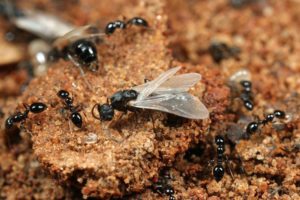While most ants we encounter are wingless, diligently working to build their colony and gather food, a fascinating phenomenon occurs at certain times of the year: the emergence of winged ants, soaring through the air in swarms. These flying ants, often a source of curiosity and sometimes annoyance, are not simply a different species, but rather a specific life stage within the ant colony.

The winged ants, known as “alates,” are actually sexually mature reproductive individuals, specifically male drones and virgin queens. These individuals are produced by the colony once a year, marking a crucial moment in the ant life cycle.
Their wings, a temporary feature, serve a singular purpose: to allow these alates to embark on a dramatic and vital journey. They take flight, participating in a spectacular aerial mating ritual known as the “nuptial flight.” During this flight, the virgin queens, the future founders of new colonies, will mate with the drones, collecting sperm to ensure the future generations of their colony.
The wings, once essential for this crucial mating flight, are subsequently shed by the queens, leaving them to establish a new colony and lay their eggs. The drones, having fulfilled their reproductive role, will typically die shortly after mating.
The presence of winged ants is thus a reminder of the complex social structure and reproductive strategies within ant colonies. It highlights how, despite their often-unassuming appearance, ants are incredibly organized and possess fascinating evolutionary adaptations that allow them to thrive and expand their colonies.
This phenomenon, while temporary, is essential for the continuation of ant colonies. It is a fascinating glimpse into the hidden world of these hardworking insects, a reminder that even seemingly simple creatures possess complex and fascinating life cycles.
 Pazionmedia.com Pazion Media l Latest News l Politics l Sports l Entertainment
Pazionmedia.com Pazion Media l Latest News l Politics l Sports l Entertainment



